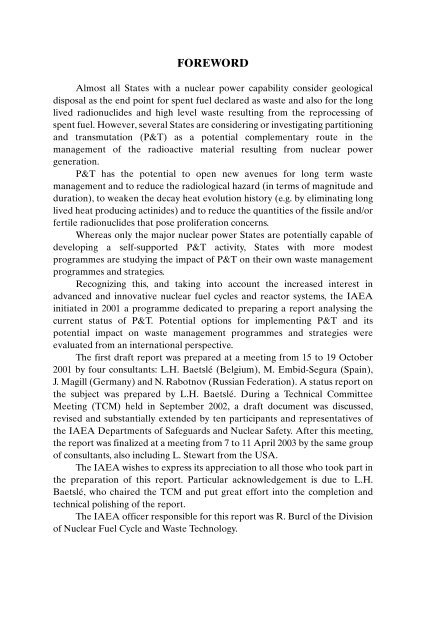TRS435_web
TRS435_web
TRS435_web
You also want an ePaper? Increase the reach of your titles
YUMPU automatically turns print PDFs into web optimized ePapers that Google loves.
FOREWORD<br />
Almost all States with a nuclear power capability consider geological<br />
disposal as the end point for spent fuel declared as waste and also for the long<br />
lived radionuclides and high level waste resulting from the reprocessing of<br />
spent fuel. However, several States are considering or investigating partitioning<br />
and transmutation (P&T) as a potential complementary route in the<br />
management of the radioactive material resulting from nuclear power<br />
generation.<br />
P&T has the potential to open new avenues for long term waste<br />
management and to reduce the radiological hazard (in terms of magnitude and<br />
duration), to weaken the decay heat evolution history (e.g. by eliminating long<br />
lived heat producing actinides) and to reduce the quantities of the fissile and/or<br />
fertile radionuclides that pose proliferation concerns.<br />
Whereas only the major nuclear power States are potentially capable of<br />
developing a self-supported P&T activity, States with more modest<br />
programmes are studying the impact of P&T on their own waste management<br />
programmes and strategies.<br />
Recognizing this, and taking into account the increased interest in<br />
advanced and innovative nuclear fuel cycles and reactor systems, the IAEA<br />
initiated in 2001 a programme dedicated to preparing a report analysing the<br />
current status of P&T. Potential options for implementing P&T and its<br />
potential impact on waste management programmes and strategies were<br />
evaluated from an international perspective.<br />
The first draft report was prepared at a meeting from 15 to 19 October<br />
2001 by four consultants: L.H. Baetslé (Belgium), M. Embid-Segura (Spain),<br />
J. Magill (Germany) and N. Rabotnov (Russian Federation). A status report on<br />
the subject was prepared by L.H. Baetslé. During a Technical Committee<br />
Meeting (TCM) held in September 2002, a draft document was discussed,<br />
revised and substantially extended by ten participants and representatives of<br />
the IAEA Departments of Safeguards and Nuclear Safety. After this meeting,<br />
the report was finalized at a meeting from 7 to 11 April 2003 by the same group<br />
of consultants, also including L. Stewart from the USA.<br />
The IAEA wishes to express its appreciation to all those who took part in<br />
the preparation of this report. Particular acknowledgement is due to L.H.<br />
Baetslé, who chaired the TCM and put great effort into the completion and<br />
technical polishing of the report.<br />
The IAEA officer responsible for this report was R. Burcl of the Division<br />
of Nuclear Fuel Cycle and Waste Technology.


